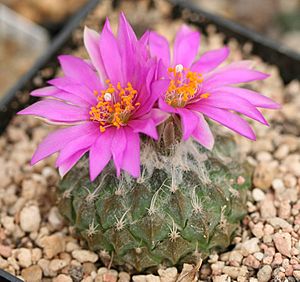Pelecyphora strobiliformis facts for kids
Quick facts for kids Pelecyphora strobiliformis |
|
|---|---|
 |
|
| Conservation status | |
| Scientific classification |
Pelecyphora strobiliformis is a very special type of cactus that grows naturally in Mexico. It has a unique shape that makes it look a bit like a small pinecone. This interesting plant is quite rare in the wild, and its numbers have gone down because people sometimes collect them.
Contents
Discovering Pelecyphora strobiliformis
This unique cactus was first officially described in 1927. It belongs to a group of plants called Cactoideae, which includes many different kinds of cacti. Scientists gave it the name Pelecyphora strobiliformis because of its distinct look.
What Does It Look Like?
The Pelecyphora strobiliformis cactus is usually small, often growing only a few centimeters tall. Its body is covered in small, scale-like bumps, which are actually its tubercles. These tubercles overlap, giving the cactus its famous pinecone-like appearance. It can also produce small, pretty flowers, often pink or purple, that bloom from the top of the plant.
Where Does It Grow?
This cactus is native to specific dry regions in Mexico. It thrives in rocky, desert-like areas where the soil is well-drained. Like many cacti, it is very good at surviving in places with little water. Its natural home is an important part of its survival.
Protecting This Cactus
Because Pelecyphora strobiliformis is rare and its wild populations have shrunk, it needs protection.
- The IUCN lists it as "Least Concern". This means that, overall, the species is not currently at high risk of disappearing.
- However, it is also listed in Appendix I of CITES. CITES stands for the Convention on International Trade in Endangered Species of Wild Fauna and Flora. Being in Appendix I means that international trade of this cactus is very strictly controlled. This helps to stop people from taking too many from the wild and selling them.
Protecting plants like Pelecyphora strobiliformis is important for keeping our planet's biodiversity healthy.
See also
 In Spanish: Pelecyphora strobiliformis para niños
In Spanish: Pelecyphora strobiliformis para niños


